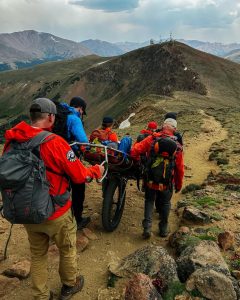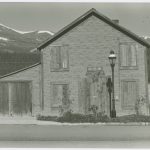‘Inherent risks’: Colorado avalanche forecaster rescued after being caught in slide near I-70 tunnels
In a multi-hour mission, the Alpine Rescue Team helped extract the Colorado Avalanche Information Center forecaster from the field

Colorado Avalanche Information Center/Courtesy photo
A Colorado Avalanche Information Center forecaster was caught and partially buried in an avalanche Monday, April 8, on the Front Range.
Colorado Avalanche Information Center Deputy Director Brian Lazar said that the forecaster, who has not been identified, is recovering after rescuers extracted him from the field Monday evening, April 8. He did not sustain any major injuries.
“This points out that even professionals with a well-reasoned trip plan can make mistakes,” Lazar said. “Though we can do a really good job of reducing the risk of avalanches, you can never reduce that risk to zero when working in a backcountry environment.”
The forecaster triggered the D2 size avalanche — large enough to bury, kill or injure a person — around 11,800 feet on a northeast slope of Mt. Bethel, which is located two valleys east of the Interstate 70 Eisenhower-Johnson Memorial Tunnels, Lazar said.
The avalanche occurred just before 2 p.m. as the forecaster was making his way down from the field site, Lazar said. The forecaster was caught and carried a short distance in the avalanche before becoming pinned against some trees, he said.
As part of its field safety program, the Colorado Avalanche Information Center keeps tabs on its forecasters, so when this forecaster did not check in at the predetermined time, team members started mobilizing to go out to the site, Lazar said. Contact was also reportedly made with the injured forecaster using a Garmin inReach satellite device.
“Any job that requires you to operate in the mountainous environment will carry with it certain inherent risks including moving through avalanche terrain” Lazar said. “Lots of things have the potential to go wrong when you’re doing field work, from broken equipment to a twisted knee to, of course, avalanches.”

The all-volunteer Alpine Rescue Team received notice of the avalanche entrapment around 5:45 p.m., Dale Atkins, a decades-long member of the group, said that he arrived at the trailhead about an hour later, just as other team members were heading into the field.
The Colorado Avalanche Information Center already had staff members on the trail to the injured forecaster, and Alpine Rescue Group was close behind, Atkins said. In addition to a team going in on foot, Flight for Life was called to fly rescuers into the field.
Soon, two rescuers were dropped near the accident site and made their way to the injured forecaster on skis. The team that had gone in on foot had already dug the forecaster out, but he was very cold and suffering from the early stages of hypothermia, Atkins said. By just after 8 p.m., the rescue team had treated the forecaster’s injuries, wrapped him in warm layers and strapped him to a toboggan, he said.
Darkness had settled as a team of about 10 rescuers started down the mountain with the forecaster in the toboggan, Atkins said. Thick, breakable snow from winds late last week made the skiing tricky as the team side slipped down a steep slope, sometimes using trees as anchors to lower the toboggan, he said.
“We started down in the dark,” Atkins said. “We had an about 700-foot timber bash with some small avalanche slopes that had to be navigated, heading down through the trees.”

After about an hour, the rescuers reached the valley bottom and followed the summer trail back to the trailhead off Interstate 70, reaching the parking lot and loading the forecaster into an ambulance around 10 p.m., Atkins said.
While avalanches involving backcountry professionals are exceedingly rare, they’re not impossible, Lazar said. Like any avalanche, the Colorado Avalanche Information Center treats avalanche accidents involving its own people seriously and will not release an individual’s personal details without their permission, he added.
Colorado Avalanche Information Center staff returned to the site of the avalanche accident Tuesday, April 9, and will release a full report on the incident in the coming days.
Atkins noted that this avalanche incident highlighted the importance of carrying a satellite communication device, such as a Garmin inReach, for when there is no cell phone coverage in the backcountry.
- Navigation — map (for your area) and compass, GPS and extra batteries or charger
- Signaling — whistle, mirror, cell phone, surveyor tape
- Light source (two) — headlamp, flashlight, extra batteries for both
- Nourishment — water and high-energy food for 24-48 hours
- Shelter — waterproof tarp, bivvy sack, parachute cord
- Fire building — waterproof matches or lighter, heat tabs, knife
- Personal aid — First-aid kit with medications, sunscreen, dark glasses, bug repellant
- Weather protection — extra socks, warm gloves, rain gear, hat, bug net
- Winter extras — avalanche beacon, probe, shovel with metal blade
- Rules to follow — always leave a schedule and trip plan with someone at home, stay on the trail, wait for search and rescue if you become lost
Backcountry users should do everything they can to make themselves “searchable” to help rescuers locate them in the case of an emergency, Atkins said. That can include wearing an avalanche transceiver, a RECCO reflector, carrying a whistle, wearing bright clothing and having a satellite communications device in addition to a cell phone, he said.
The fact that this avalanche caught and injured a professional highlights the real risks recreationalists face in the backcountry, Atkins said. It should serve as a reminder that anyone that heads into the backcountry should check the avalanche forecast before leaving and should carry the 10 essentials, including an avalanche transceiver probe and shovel, he said.
“This avalanche happened to the best of the best,” Atkins said. “It just shows the challenges of traveling in the backcountry. This was not scary looking terrain. It wasn’t steep gullies or gnarly cliff bands. It’s the kind of terrain backcountry skiers would like to play in. But this forecaster wasn’t playing in it. He was working.”

Support Local Journalism

Support Local Journalism
As a Summit Daily News reader, you make our work possible.
Summit Daily is embarking on a multiyear project to digitize its archives going back to 1989 and make them available to the public in partnership with the Colorado Historic Newspapers Collection. The full project is expected to cost about $165,000. All donations made in 2023 will go directly toward this project.
Every contribution, no matter the size, will make a difference.








